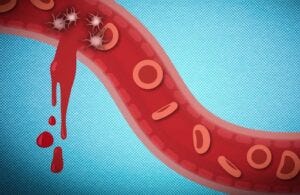MIT researchers study the best size for nanoparticles to stop internal bleeding
FEBRUARY 17, 2022 BY SEAN WHOOLEY
I am sharing this article because of what the science says it does. It stops internal bleeding with Nanoparticles. Nanoparticles we have reviewed are in the Nanovaccines, nanomedicines or bioweapons.
Consider then the possibility that this research in CLOTTING BLOOD within the body, with nanotech is already underway, and at MIT no less.
“MIT researchers are examining how different-sized polymer nanoparticles circulate in the body, with a goal of treating traumatic injuries.
Researchers are developing injectable nanoparticles that can attract cells to help stop the bleeding at the site of an internal injury until a patient can get to a hospital for treatment. To highlight the mechanism of action and safety of the particles, chemical engineers at MIT have studied how they circulate in the body and interact with the platelets that promote blood clotting.
According to a news story on the university’s website, the MIT engineers performed the first systematic study of how the different-sized polymer nanoparticles circulate and interact. The study — funded by the U.S. Army Research Office through the Institute for Soldier Nanotechnologies at MIT and the Department of Defense — aims to offer insight into those aspects of the nanoparticles that have shown promise in animal studies but haven’t been tested in humans due to a lack of information.”
unless of course the ‘certain size’ and ‘charge’ of the nanoparticles found their way into the vaccines. which I have already published and many have the articles discussing this.
So it takes NO IMAGINATION AT ALL THAT IF THIS IS A TECHNOLOGY TO STOP BLOOD FLOW, BLEEDING, IT CAN go further. It can stop blood flow and impair blood flow and create clots.
Here is the movie Died Suddenly.
https://rumble.com/v1wac7i-world-premier-died-suddenly.html
“In a study of rats, the researchers demonstrated that particles in an intermediate size range (around 150 nanometers in diameter) were most effective at stopping bleeding. The 150 nm particles were much less likely to travel to the lungs or other off-target sites, in contrast to larger particles that often do so, MIT said.”
Well how interesting. various sized nanoparticles will fit in various sized capillaries, (eye sight hearing, cross blood brain in lpn,) veins and arteries and stop bleeding.
WELL MIT SAYS IT’S SO. CAN ANYONE SEND THIS TO STEW PETERS? I’m banned from Twitter.
“Paula Hammond, an MIT Institute professor, head of MIT’s Chemical Engineering Department and a member of the university’s Koch Institute for Integrative Cancer Research, was a senior author of the study. Bradley Olsen and George Velhmahos were also senior authors, while MIT graduate student Celestine Hong is the lead author for the paper that appears in ACS Nano.”
“With nanosystems, there is always some accumulation in the liver and the spleen, but we’d like more of the active system to accumulate at the wound than at these filtration sites in the body,” Hammond said in the post on MIT’s news site.”
Liver cancer rates are surging in Australia – and climate change could be to blame
YES AUSTRALIA, LAND OF THE ULTRA VAXED HAS LIVER CANCER. MIT says nano accumulates in the Liver. Nothing to see here. No relations. It’s climae change.
“The researchers used the PEG-PLGA polymer, conjugated with the peptide GRGDS, to create polymeric particles and assess how the size affects interactions with the wound. They analyzed small (less than 100 nanometers), intermediate (140 to 220 nanometers) and large (500 to 650 nanometers) nanoparticles.
In the study, the researchers looked at how particles bound to platelets and analyzed how much of the mass stuck to the surface was nanoparticles and how much was platelets, observing that intermediate-sized particles were the most effective.
“If you attract a bunch of nanoparticles and they end up blocking platelet binding because they clump onto each other, that is not very useful. We want platelets to come in,” Hong said. “When we did that experiment, we found that the intermediate particle size was the one that ended up with the greatest platelet content.”
They also looked at the different sizes of nanoparticles in mice, observing injections in healthy mice to see how long they would circulate in the body and where they would accumulate.
In collaboration with Massachusetts General Hospital, the researchers used a rat model of internal injury to study which particles would be most effective at stopping bleeding. Intermediate particles proved to work the best and showed the greatest accumulation rate at the wound site.
With new information about how the injectable nanoparticles work, the researchers will look to test them in larger animal models to determine the safety levels and most effective doses.
“These particles are meant to address preventable deaths,” Hong said. “They’re not a cure-all for internal bleeding, but they’re meant to give a person a few extra hours until they can get to a hospital where they can receive adequate treatment.”
I wonder what the nanotech does in the bodies of vax recipients. Liver spots and cancers on the rise? and blood clots. Please consider upgrading your subscription and for sure get this to Stew.



I posted on GETTr to Mr. Peterson
Celeste video is mind blowing and disturbing. Ties together with Katherine Watt and Sasha Latypova work.
https://rumble.com/v2lxwrk-exclusive-celeste-solum-the-end-game-synthetic-biology-exposed.html